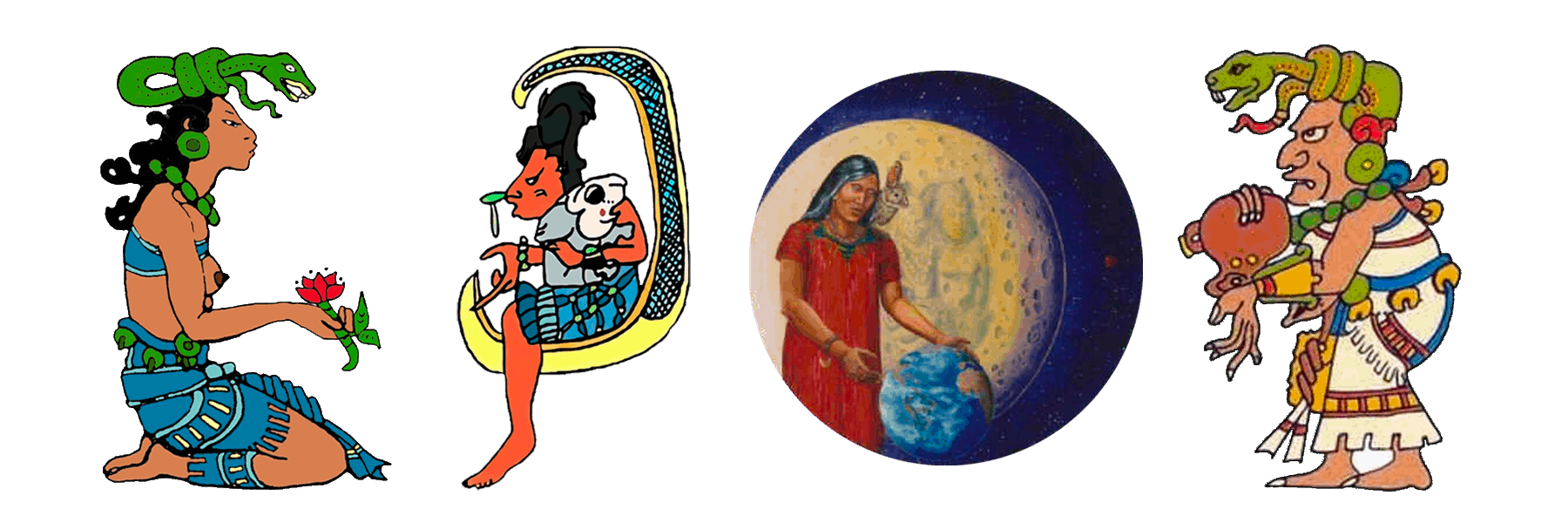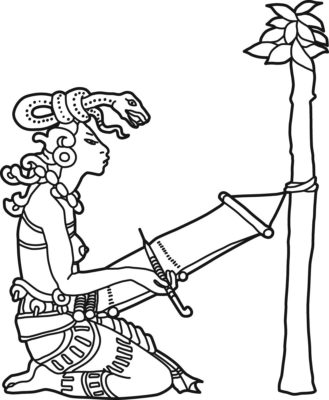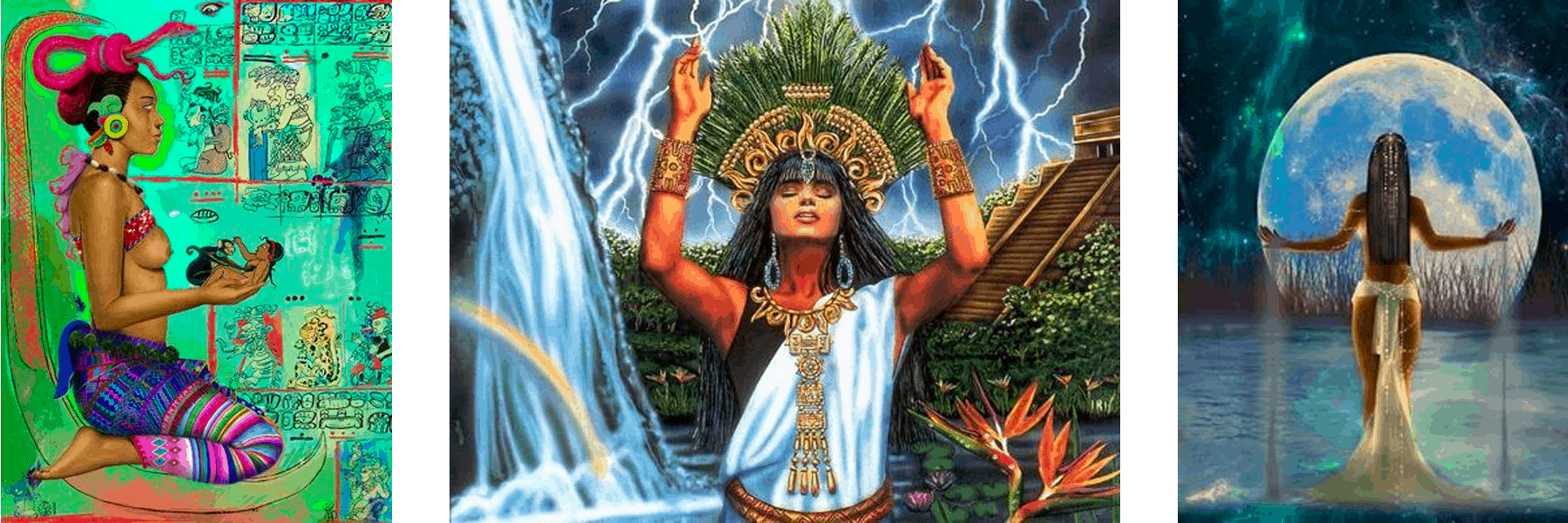Ix Chel
Lady Rainbow
On one of our very first forays into the jungle searching for medicinal plants, Don Elijio said that “walking in the mountains with a woman was very good luck.” We trudged further up the mountainside toward the rising sun. “Ix Chel shows her medicine more readily when a healer walks with a woman.” Out of breath trundling along behind him, I asked, “Who is Ix Chel?” Patiently, as if speaking to a child, he answered, “She is the Goddess of healing. Women pray to her for fertility and she brings dream visions to healers and weavers. She is my very best friend."

Immediately fascinated by this Goddess of the Americas. I began a decades long personal research project to learn more about her that continues to this day. Eventually, she became the patroness and spiritual guide of our Maya Abdominal Therapy profession and association. I named my tropical homestead, Ix Chel Farm, in Belize after her and later founded the Ix Chel Tropical Research Centre to further the study and preservation of traditional healing of Central America. Eventually, she became the patroness and spiritual guide of our Maya Abdominal Therapy and Maya Spiritual Healing profession and association.
Cozumel Island, the site of her temple, was once named Cuzamil or Place of the Swifts by Spanish Conquistadores and in more ancient days it was known as, Tantun or Built on Stone. Like Most Maya sties, it was mostly abandoned sometime during the 10th century but Maya women continued to make pilgrimages to the site until the 1600’s. Bishop Landa referred to the women there as “site of those infamous idolaters where women go for partuition.” Maya women of all ages went to Cuzamil to be trained in women’s mysteries, astrology, healing with herbs, prayers and massage as well as divination and calendric studies. Every Maya woman was obliged to make two pilgrimages in a lifetime to visit the sacred island, one at menarche and the second at menopause. The early Spanish chronicles relate that women came from as far away as Tenochitlan (present day Mexico City) and as far south as Nicaragua and Panama.
At Pole, the sight of present-day Playa del Carmen, Cuzamil pilgrims were given free housing and meals until a wooden ocean-going canoe and paddlers were arranged to carry them across the seas – a twelve hour dangerous journey. Only very few men, members of a hereditary lineage, knew of the secret currents to the island. Those who tried to paddle to Cuzamil without knowledge of the these powerful currents would invariably be swept back to the mainland again and again. Today in Yucatan, this crossings, La Travesia, is re-enacted each May from Tulum to Cozumel.
Ix Chel dancing with the Rain God and the Corn God from a temple at Tulum, Mexico
As the home of the Goddess of Love, women brought offerings to Cuzamil to request a well-matched, prosperous married life. After marriage, they made pilgrimages to request fertility and uncomplicated birth outcomes. I imagine that childless women, often ostracized, would have been welcomed at Cuzamil and given productive work to do, where they raised bees for honey and tended to orphaned children brought to the island by relatives who feared they would be sacrificed. Elder women came to give thanks for the children they bore and brought their daughters of marriageable age to complete their first pilgrimage.
Many Maya women traveled to Cuzamil to give birth because to be born on the Goddess’ island bestowed great honor and prestige. The high priestess and oracle, leader of the island and direct representative of Ix Chel, prophesized for Her in a trance from inside of a seven foot clay image of the Goddess. Other women gave agricultural prophesies based on the flight of the swifts that came annually to roost in towers on the island. Spanish chronicles relate that the women of Cozumel Island were expert astronomers with their own observatory and planetary charts.
Lucrative trade routes from all over ancient Mexico, Guatemala, Belize and countries to the south made Cuzamil incredibly wealthy. Every trader gave 20% share of profits to the island’s administration. All pilgrims who worshiped on the island brought tribute in the form of cacao beans, jade stones, amber, turquoise, feathers and embroidered mantles, currency of the times.

There is a legend that between 600-800 AD, under the rule of a certain High Priestess, only women and children could live on the island. Here, were sheltered orphans (a common choice for sacrifice), widows, barren women, abused women, lesbians and all who needed or chose to live on the island.
The Island of Women, my first novel is about Cuzamil during that two hundred year era of women’s rule. It is followed by a sequel, The Island of Women.
The Maya words Ix Chel have many interpretations. Ix means woman, Goddess, divine feminine; Chel means rainbow or translucent light. Her name is Lady Rainbow or Goddess of Divine Translucent Light. Ix Chel was always associated with bodies of water like lakes, rivers, creeks, streams and oceans where it is more likely to see rainbows and her beautiful sparkling light. Even in modern times, women sleep at watersides and pray to her for guidance in a dream – myself included. Just as in ancient days, many Maya women still relate that their weaving patterns were divined in dreams.
Can you see Ix Chel’s image?
Like many other Goddesses of the world, Ix Chel depicts the three stages of a woman’s life:
The first image is of young Ix Chel the maiden, Goddess of weaving. She wears a snake on her forehead to signify that she is the Goddess of medicine and to symbolize intuitive knowledge as well as great control over earthly forces. She was responsible for the formation of a baby in the mother’s womb and decided if a child would be male or female. Maya midwives placed her image carved in cedar wood under the birthing bed. Each student of midwifery was given a cedar-carved image of the maiden goddess upon completing her studies on the island. Like their ancient sisters, modern Maya women continue to make pilgrimages to San Gervasio temple before they marry to ask for fertility, a loving partner and the right amount of girls and boys to complete their families.

Ix Chel, the mother, Goddess of Fertility, Motherhood and the Moon. As wife of the great Creator Father, Itzamna, she and he were the Divine Parents, co-creators of the universe. Considered to be the mother of all Maya people, she sits elegantly posed on a crescent moon which represents the cycles and phases of a woman’s reproductive life. In her hands she holds a rabbit, another Maya fertility symbol. Notice that Ix Chel the Mother has no snake on her head. Maya women tell me that it is because mothers are too busy taking care of their own brood to work as healers.
Ix Chel, the Mother Goddess of sexual desire, fertility, the moon and motherhood. As Mother Creator of all Maya people and consort of the Creator God, Itzamna, she decided the face and sex of every person in utero. She and Itzamna (Lizard House or House of Sacred Divining Stones) lived at the crown of the ceiba tree where they invented sexual intercourse to create the world and its people. From their sexual union were born the seed pods of the great ceiba. When they fell to the earth, they became human beings, trees, animals, water ways, planets and stars. The Mother Goddess sits elegantly poised on a crescent moon to signify the moon’s effect on menstrual change and fertility. The Maya saw the shadows in the moon as the outline of a rabbit, thus the Goddess holds a rabbit in her arms, another fertility symbol. The Maya discovered that one moon cycle and one menstrual cycle are both 29.5 days. The calendar priests determined their famous 260 day Tzolkin calendar based on women’s menstrual cycles and the duration of pregnancy.

The third image is the Grandmother Earth Goddess of the moon, rain, medicine and death. She receives and absorbs the bodies of her deceased children into her physical body, the earth. Revered for her wisdom and knowledge, her glyph demonstrats the vital importance and maximum respect of elders. Again, we see Ix Chel with the snake on her head, signifying medicine, healing and intuitive wisdom. Only the maiden and grandmother have a snake (to symbolize medicine) on the forehead because (as Maya women have told me) the Mother Goddess is too busy raising and caring for her own brood. Grandmother Ix Chel’s clay pot, shaped like a uterus, pours down rain to fertilize the earth. Often glyphs show a rainbow pouring out of her clay pot. Ix Chel was also consort and wife to the rain god, Chac, one of the Nine Benevolent Spirits that guide the Maya people to this day. Interestingly, this Goddess had many husbands – among them were: Itzamna the Creator God; Chac the Rain God; Ah Puuc, the God of Death; Ah Kin the Sun God and the Vulture God.

The Great Mother, Ix Chel
"This is a tale of the Great Mother, Ix Chel, she who is the Heart of Water; she who is in white stones; she whose home is in caves and she who is the mother of all animate and inanimate beings of the Known World.
When Ix Chel was a young woman, she was too independent and headstrong to be controlled by any god either in heaven or in hell. Her Father, Hunab Ku, the greatest of all the gods, tried to keep her home so he could teach her to be obedient, but one day while he was out, she eloped to marry the Sun God. That made her father furious. So, he hurled a bolt of lightning at her. In anger, he killed his own daughter. Swarms of dragonflies came to her where she lay. For thirteen days they sang and buzzed their wings over her until she was finally revived. She returned to the home of her husband, the Sun God.
Now, in time, the Sun God became angry at her because she would not obey him. He began to beat her and to mistreat her until she ran away with the God of the Morning Star and hid from her cruel husband and angry father. Soon, the Morning Star God, became weary of her refusal to obey him and he tried to lock her up. Again, she escaped. This time Ix Chel ran away with the God of the Vultures. The Sun God heard of this and made a plan to retrieve his wife from the land of the vultures. He killed a deer and climbed inside the skin pretending to be dead. When the vultures came to eat, the Sun God grabbed one of them by the wing and forced him to take him to the house of the king vulture. When the Sun God arrived, he and the Vulture God had a terrible fight but the Sun God was victorious and ran away with Ix Chel. Soon, she tired of his jealousy again.
They quarreled causing the heavens to thunder and send down bolts of lightning to earth. The Sun God was very angry at his wife. He took away her brilliant rainbow colors and left her with only the pale light of the moon. Ix Chel had a pet rabbit. She escaped from the fury of the Sun God with him. She hid herself in the moon and now she wanders the nights making herself invisible whenever her cruel husband shows his brilliant, fiery head. From each of these gods; the Sun, the Morning Star and the King Vulture, our Mother birthed children who are now walking on this earth and have established all of the lineages of our people. Ix Chel still hides herself from her husband in the dark, night sky. She is the rainbow that lights up the days of rain. She shows her love for us when she rises to light up the darkness. During the dark days of the moon, she is resting from her travels. You can see her sitting in the moon holding her rabbit while they watch over the Earth, take care of women and children, guide our healers and take our bodies into hers when we die.”
“The 6th Sun signals the return of the divine feminine as an archetype. We rescued the Maya goddess, Ix Chel, from dusty corners of history, and our devotion to her is part of the return of the divine feminine that will be a softer way to live together on Gaia. This is the death knoll for patriarchy, aggression and attitudes of fear and shame towards sex. Ix Chel, goddess of sexuality, claimed her power when she ran away from the abusive Sun God to rule her own realm in the night sky as the moon.
Be grateful that we have Ix Chel, her myths, her temple, to teach us about the divine feminine, self-empowerment and loving service through healing. Be grateful that she guides and protects us, responds to our prayers and helps us to heal and to be healed. Be grateful that she has revealed the true purpose of her island sanctuary for women on Cozumel Island. In her own way, she has acknowledged our work and pilgrimages to her ancient temples."

“Hail Ix Chel Mother of All Creation. Blessed art Thou amongst women and blessed is the fruit of the womb, all Creation. Holy Ix Chel Mother of all pray for us now and at the hour of our trials. Amen”